Abstract
The ability of adenosine and structurally-related compounds to inhibit epileptiform activity induced by bicuculline in the CA3 region of the hippocampal slice of the rat was examined. Bath application of all purinoceptor agonists tested reduced the frequency of generation of burst potentials. Analysis of dose-response curves yielded the following IC50 values: adenosine, 1.5 microM; 2-chloroadenosine, 0.144 microM; 5'-(N-ethyl)carboxamidoadenosine, 30.2 nM; L-phenylisopropyladenosine, 12.1 nM; cyclohexyladenosine, 7.9 nM. Theophylline (30 microM) increased the rate of bursting and antagonized the effect of exogenous adenosine. Dipyridamole (0.03-1 microM) reduced the occurrence of burst firing. In slices untreated with bicuculline, theophylline (30 microM) and adenosine deaminase (10 micrograms ml-1) induced bursting activity. These results demonstrate that purinoceptor agonists can suppress epileptiform activity in the hippocampus and suggest that adenosine may act as an endogenous anticonvulsant.
Full text
PDF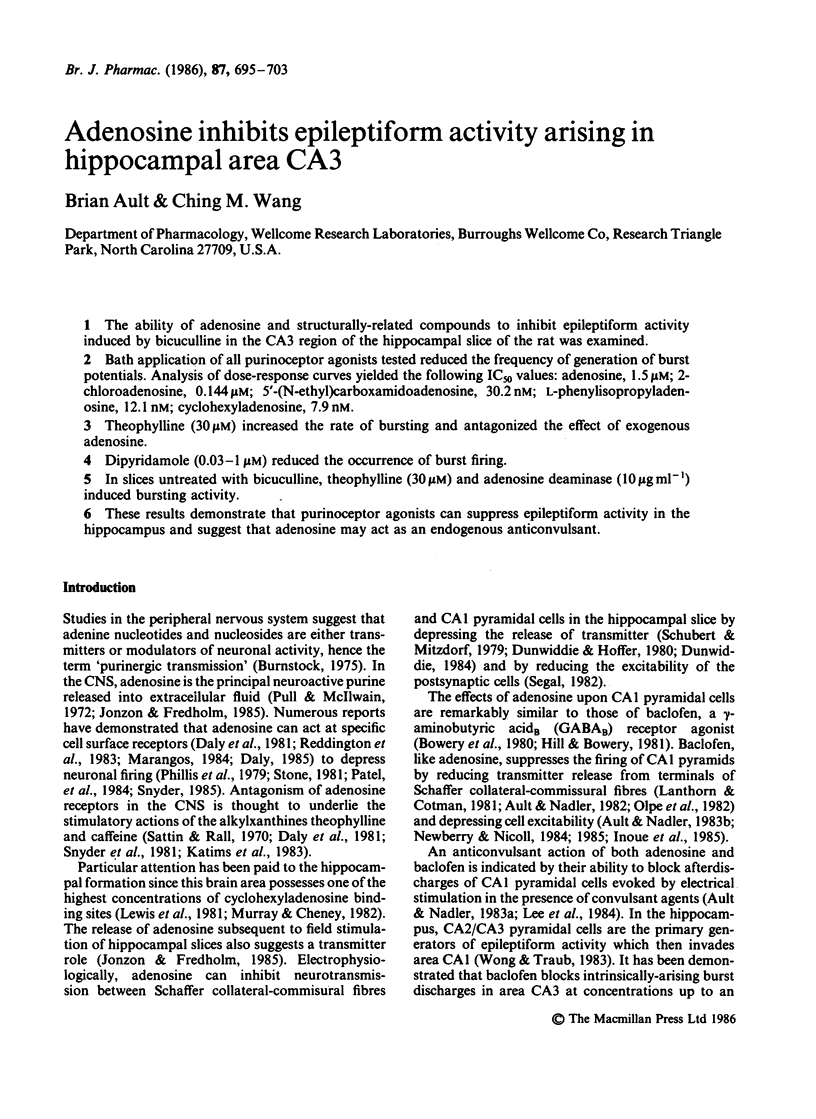
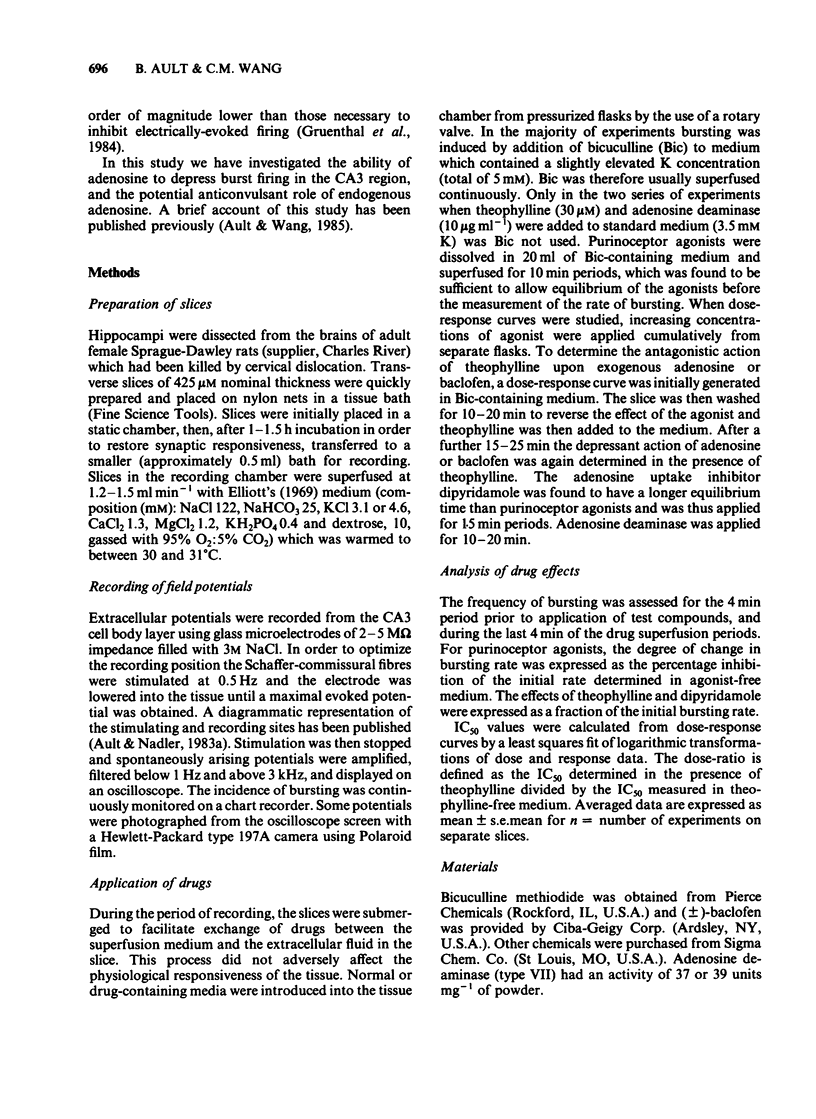

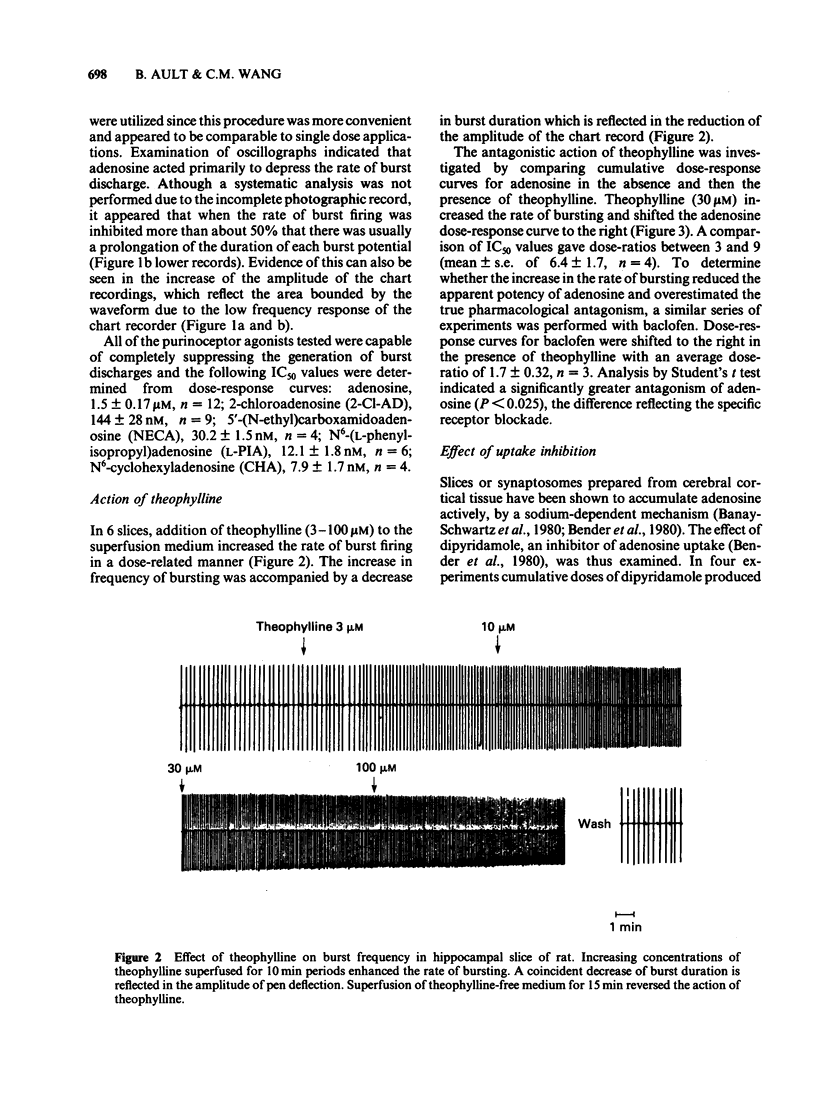
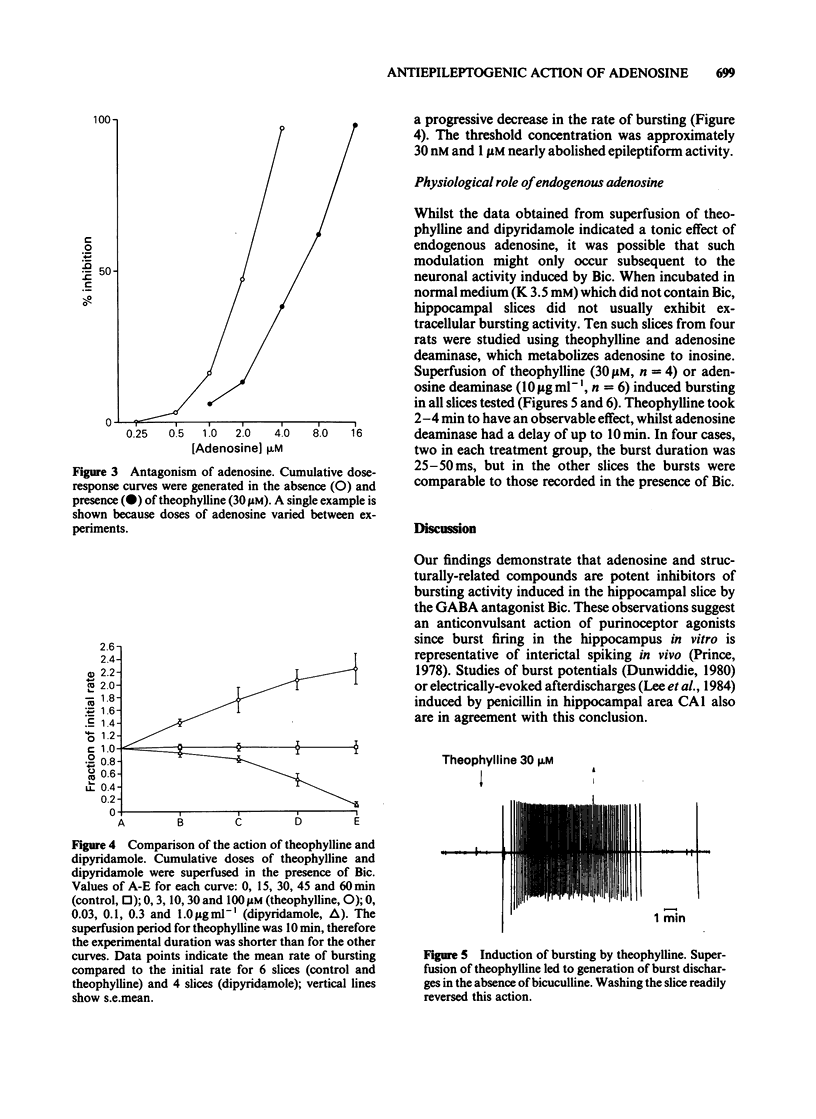
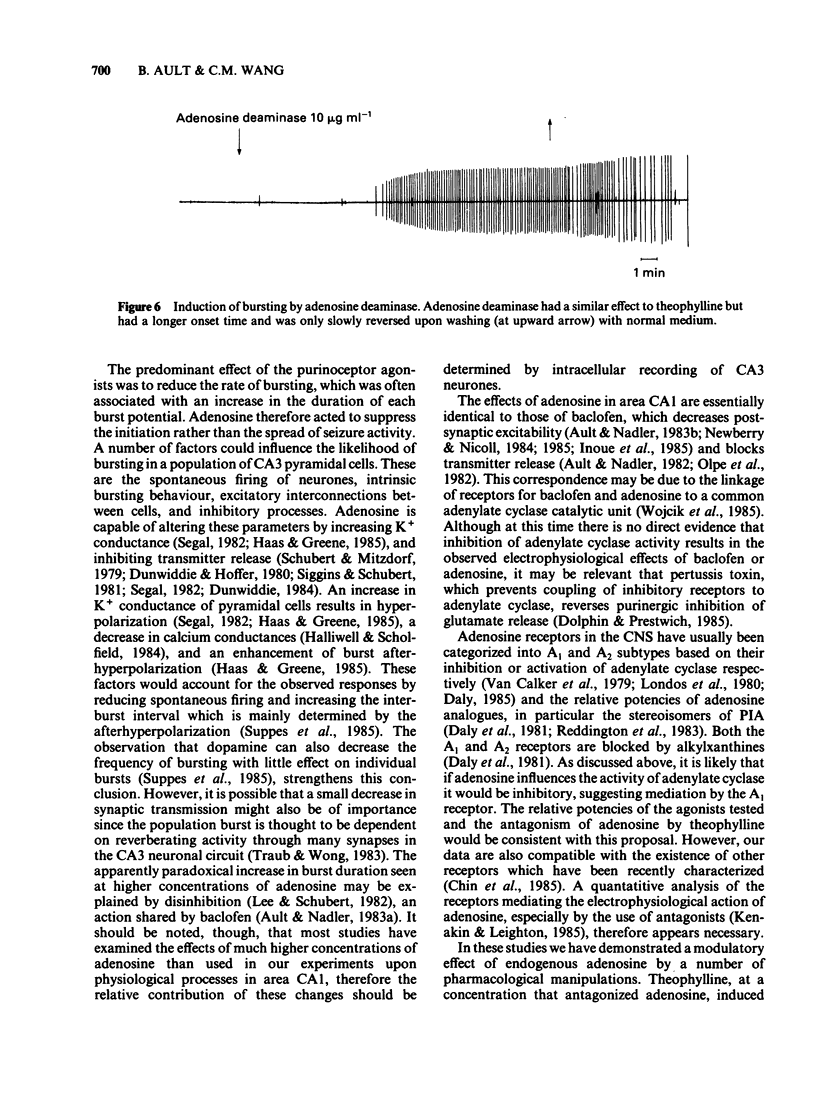
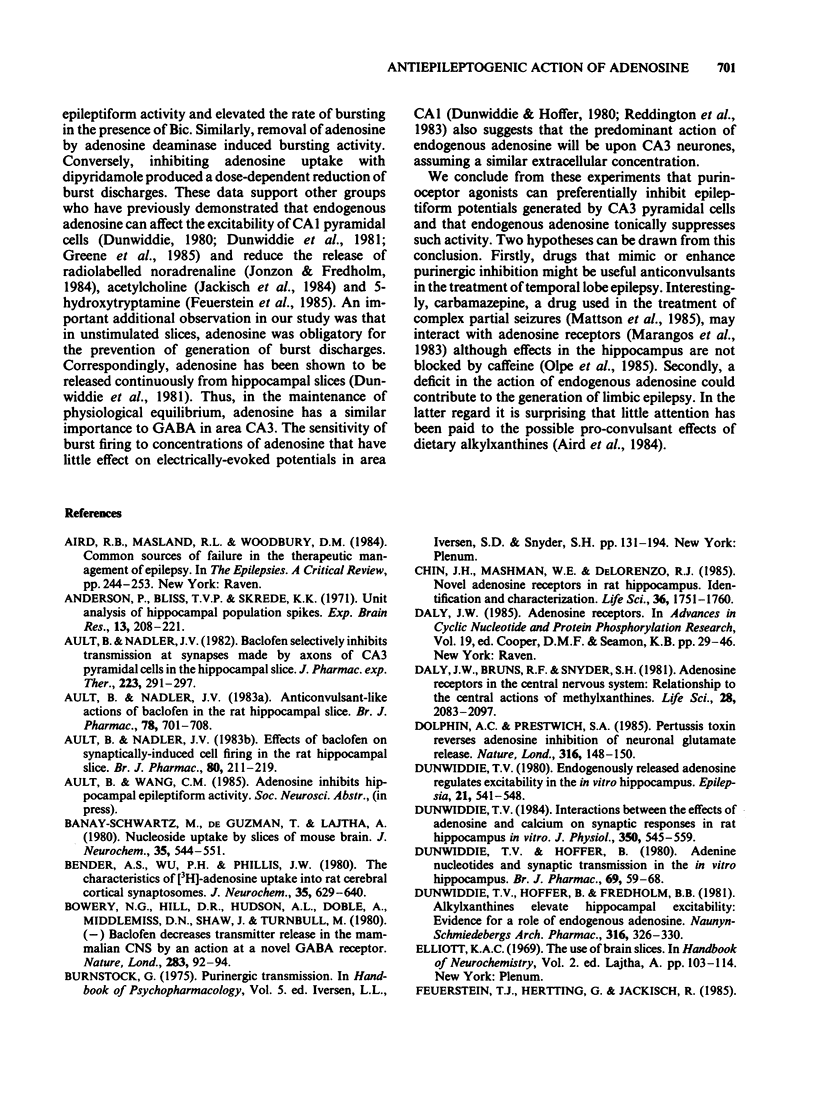
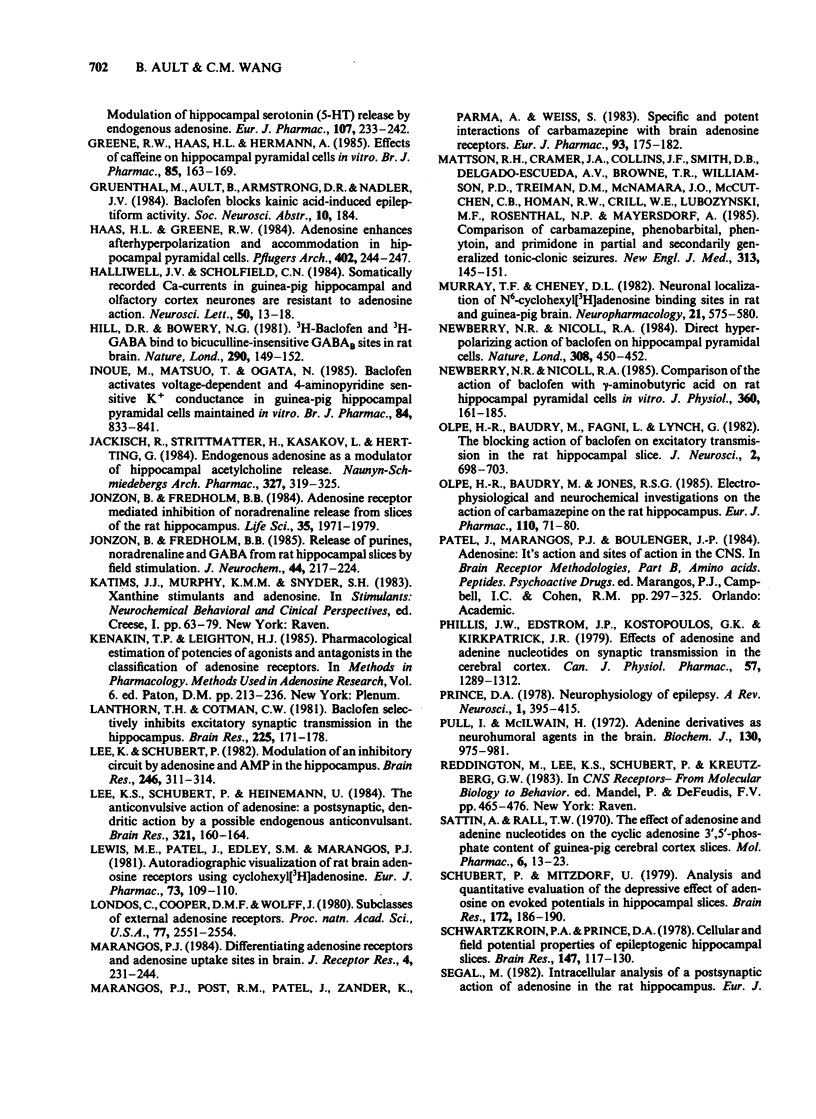
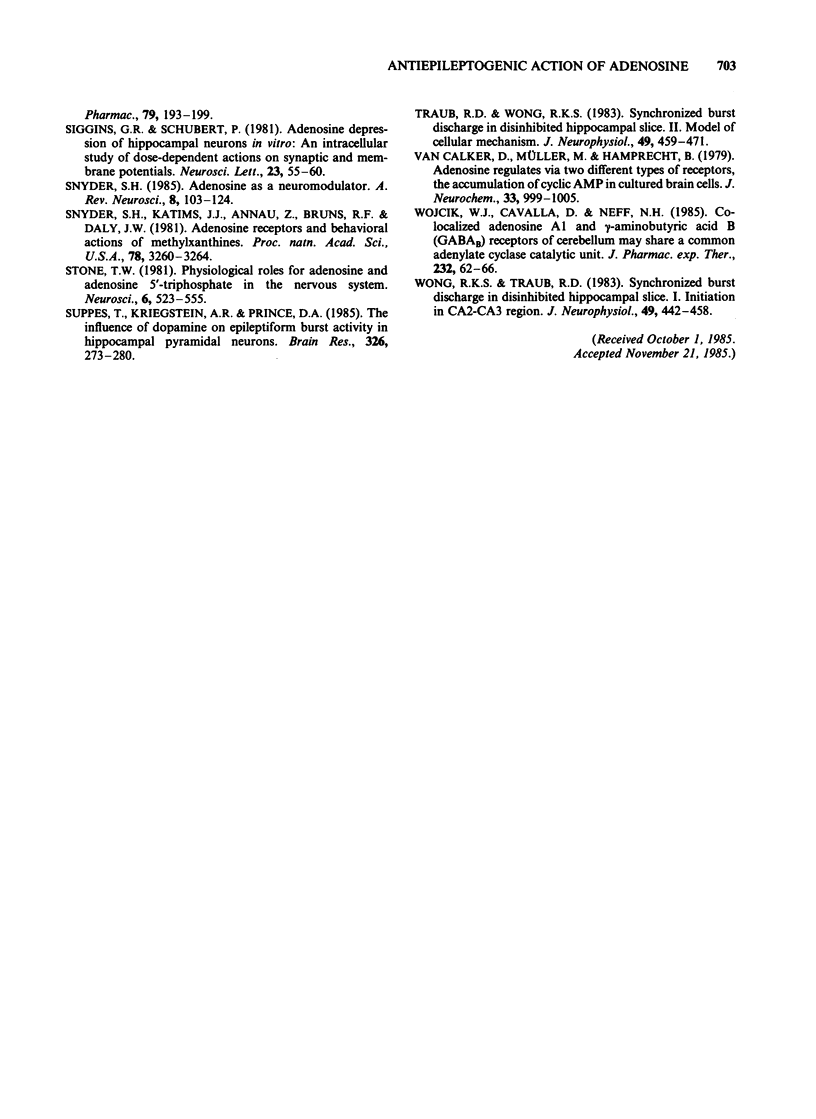
Selected References
These references are in PubMed. This may not be the complete list of references from this article.
- Andersen P., Bliss T. V., Skrede K. K. Unit analysis of hippocampal polulation spikes. Exp Brain Res. 1971;13(2):208–221. doi: 10.1007/BF00234086. [DOI] [PubMed] [Google Scholar]
- Ault B., Nadler J. V. Anticonvulsant-like actions of baclofen in the rat hippocampal slice. Br J Pharmacol. 1983 Apr;78(4):701–708. doi: 10.1111/j.1476-5381.1983.tb09423.x. [DOI] [PMC free article] [PubMed] [Google Scholar]
- Ault B., Nadler J. V. Baclofen selectively inhibits transmission at synapses made by axons of CA3 pyramidal cells in the hippocampal slice. J Pharmacol Exp Ther. 1982 Nov;223(2):291–297. [PubMed] [Google Scholar]
- Ault B., Nadler J. V. Effects of baclofen on synaptically-induced cell firing in the rat hippocampal slice. Br J Pharmacol. 1983 Sep;80(1):211–219. doi: 10.1111/j.1476-5381.1983.tb11068.x. [DOI] [PMC free article] [PubMed] [Google Scholar]
- Banay-Schwartz M., de Guzman T., Lajtha A. Nucleoside uptake by slices of mouse brain. J Neurochem. 1980 Sep;35(3):544–551. doi: 10.1111/j.1471-4159.1980.tb03689.x. [DOI] [PubMed] [Google Scholar]
- Bender A. S., Wu P. H., Phillis J. W. The characterization of [3H] adenosine uptake into rat cerebral cortical synaptosomes. J Neurochem. 1980 Sep;35(3):629–640. doi: 10.1111/j.1471-4159.1980.tb03702.x. [DOI] [PubMed] [Google Scholar]
- Bowery N. G., Hill D. R., Hudson A. L., Doble A., Middlemiss D. N., Shaw J., Turnbull M. (-)Baclofen decreases neurotransmitter release in the mammalian CNS by an action at a novel GABA receptor. Nature. 1980 Jan 3;283(5742):92–94. doi: 10.1038/283092a0. [DOI] [PubMed] [Google Scholar]
- Chin J. H., Mashman W. E., DeLorenzo R. J. Novel adenosine receptors in rat hippocampus. Identification and characterization. Life Sci. 1985 May 6;36(18):1751–1760. doi: 10.1016/0024-3205(85)90558-2. [DOI] [PubMed] [Google Scholar]
- Daly J. W. Adenosine receptors. Adv Cyclic Nucleotide Protein Phosphorylation Res. 1985;19:29–46. [PubMed] [Google Scholar]
- Daly J. W., Bruns R. F., Snyder S. H. Adenosine receptors in the central nervous system: relationship to the central actions of methylxanthines. Life Sci. 1981 May 11;28(19):2083–2097. doi: 10.1016/0024-3205(81)90614-7. [DOI] [PubMed] [Google Scholar]
- Dolphin A. C., Prestwich S. A. Pertussis toxin reverses adenosine inhibition of neuronal glutamate release. Nature. 1985 Jul 11;316(6024):148–150. doi: 10.1038/316148a0. [DOI] [PubMed] [Google Scholar]
- Dunwiddie T. V. Endogenously released adenosine regulates excitability in the in vitro hippocampus. Epilepsia. 1980 Oct;21(5):541–548. doi: 10.1111/j.1528-1157.1980.tb04305.x. [DOI] [PubMed] [Google Scholar]
- Dunwiddie T. V., Hoffer B. J. Adenine nucleotides and synaptic transmission in the in vitro rat hippocampus. Br J Pharmacol. 1980 May;69(1):59–68. doi: 10.1111/j.1476-5381.1980.tb10883.x. [DOI] [PMC free article] [PubMed] [Google Scholar]
- Dunwiddie T. V., Hoffer B. J., Fredholm B. B. Alkylxanthines elevate hippocampal excitability. Evidence for a role of endogenous adenosine. Naunyn Schmiedebergs Arch Pharmacol. 1981 Jul;316(4):326–330. doi: 10.1007/BF00501365. [DOI] [PubMed] [Google Scholar]
- Dunwiddie T. V. Interactions between the effects of adenosine and calcium on synaptic responses in rat hippocampus in vitro. J Physiol. 1984 May;350:545–559. doi: 10.1113/jphysiol.1984.sp015217. [DOI] [PMC free article] [PubMed] [Google Scholar]
- Feuerstein T. J., Hertting G., Jackisch R. Modulation of hippocampal serotonin (5-HT) release by endogenous adenosine. Eur J Pharmacol. 1985 Jan 2;107(2):233–242. doi: 10.1016/0014-2999(85)90063-9. [DOI] [PubMed] [Google Scholar]
- Greene R. W., Haas H. L., Hermann A. Effects of caffeine on hippocampal pyramidal cells in vitro. Br J Pharmacol. 1985 May;85(1):163–169. doi: 10.1111/j.1476-5381.1985.tb08843.x. [DOI] [PMC free article] [PubMed] [Google Scholar]
- Haas H. L., Greene R. W. Adenosine enhances afterhyperpolarization and accommodation in hippocampal pyramidal cells. Pflugers Arch. 1984 Nov;402(3):244–247. doi: 10.1007/BF00585506. [DOI] [PubMed] [Google Scholar]
- Halliwell J. V., Scholfield C. N. Somatically recorded Ca-currents in guinea-pig hippocampal and olfactory cortex neurones are resistant to adenosine action. Neurosci Lett. 1984 Sep 7;50(1-3):13–18. doi: 10.1016/0304-3940(84)90454-3. [DOI] [PubMed] [Google Scholar]
- Hill D. R., Bowery N. G. 3H-baclofen and 3H-GABA bind to bicuculline-insensitive GABA B sites in rat brain. Nature. 1981 Mar 12;290(5802):149–152. doi: 10.1038/290149a0. [DOI] [PubMed] [Google Scholar]
- Inoue M., Matsuo T., Ogata N. Baclofen activates voltage-dependent and 4-aminopyridine sensitive K+ conductance in guinea-pig hippocampal pyramidal cells maintained in vitro. Br J Pharmacol. 1985 Apr;84(4):833–841. doi: 10.1111/j.1476-5381.1985.tb17377.x. [DOI] [PMC free article] [PubMed] [Google Scholar]
- Jackisch R., Strittmatter H., Kasakov L., Hertting G. Endogenous adenosine as a modulator of hippocampal acetylcholine release. Naunyn Schmiedebergs Arch Pharmacol. 1984 Oct;327(4):319–325. doi: 10.1007/BF00506243. [DOI] [PubMed] [Google Scholar]
- Jonzon B., Fredholm B. B. Adenosine receptor mediated inhibition of noradrenaline release from slices of the rat hippocampus. Life Sci. 1984 Nov 5;35(19):1971–1979. doi: 10.1016/0024-3205(84)90478-8. [DOI] [PubMed] [Google Scholar]
- Jonzon B., Fredholm B. B. Release of purines, noradrenaline, and GABA from rat hippocampal slices by field stimulation. J Neurochem. 1985 Jan;44(1):217–224. doi: 10.1111/j.1471-4159.1985.tb07133.x. [DOI] [PubMed] [Google Scholar]
- Lanthorn T. H., Cotman C. W. Baclofen selectively inhibits excitatory synaptic transmission in the hippocampus. Brain Res. 1981 Nov 23;225(1):171–178. doi: 10.1016/0006-8993(81)90326-7. [DOI] [PubMed] [Google Scholar]
- Lee K. S., Schubert P., Heinemann U. The anticonvulsive action of adenosine: a postsynaptic, dendritic action by a possible endogenous anticonvulsant. Brain Res. 1984 Oct 29;321(1):160–164. doi: 10.1016/0006-8993(84)90694-2. [DOI] [PubMed] [Google Scholar]
- Lee K., Schubert P. Modulation of an inhibitory circuit by adenosine and AMP in the hippocampus. Brain Res. 1982 Aug 26;246(2):311–314. doi: 10.1016/0006-8993(82)91182-9. [DOI] [PubMed] [Google Scholar]
- Lewis M. E., Patel J., Edley S. M., Marangos P. J. Autoradiographic visualization of rat brain adenosine receptors using N6-cyclohexyl [3H]adenosine. Eur J Pharmacol. 1981 Jul 17;73(1):109–110. doi: 10.1016/0014-2999(81)90155-2. [DOI] [PubMed] [Google Scholar]
- Londos C., Cooper D. M., Wolff J. Subclasses of external adenosine receptors. Proc Natl Acad Sci U S A. 1980 May;77(5):2551–2554. doi: 10.1073/pnas.77.5.2551. [DOI] [PMC free article] [PubMed] [Google Scholar]
- Marangos P. J. Differentiating adenosine receptors and adenosine uptake sites in brain. J Recept Res. 1984;4(1-6):231–244. doi: 10.3109/10799898409042552. [DOI] [PubMed] [Google Scholar]
- Marangos P. J., Post R. M., Patel J., Zander K., Parma A., Weiss S. Specific and potent interactions of carbamazepine with brain adenosine receptors. Eur J Pharmacol. 1983 Sep 30;93(3-4):175–182. doi: 10.1016/0014-2999(83)90135-8. [DOI] [PubMed] [Google Scholar]
- Mattson R. H., Cramer J. A., Collins J. F., Smith D. B., Delgado-Escueta A. V., Browne T. R., Williamson P. D., Treiman D. M., McNamara J. O., McCutchen C. B. Comparison of carbamazepine, phenobarbital, phenytoin, and primidone in partial and secondarily generalized tonic-clonic seizures. N Engl J Med. 1985 Jul 18;313(3):145–151. doi: 10.1056/NEJM198507183130303. [DOI] [PubMed] [Google Scholar]
- Murray T. F., Cheney D. L. Neuronal location of N6-cyclohexyl[3H]adenosine binding sites in rat and guinea-pig brain. Neuropharmacology. 1982 Jun;21(6):575–580. doi: 10.1016/0028-3908(82)90050-8. [DOI] [PubMed] [Google Scholar]
- Newberry N. R., Nicoll R. A. Comparison of the action of baclofen with gamma-aminobutyric acid on rat hippocampal pyramidal cells in vitro. J Physiol. 1985 Mar;360:161–185. doi: 10.1113/jphysiol.1985.sp015610. [DOI] [PMC free article] [PubMed] [Google Scholar]
- Newberry N. R., Nicoll R. A. Direct hyperpolarizing action of baclofen on hippocampal pyramidal cells. 1984 Mar 29-Apr 4Nature. 308(5958):450–452. doi: 10.1038/308450a0. [DOI] [PubMed] [Google Scholar]
- Olpe H. R., Baudry M., Fagni L., Lynch G. The blocking action of baclofen on excitatory transmission in the rat hippocampal slice. J Neurosci. 1982 Jun;2(6):698–703. doi: 10.1523/JNEUROSCI.02-06-00698.1982. [DOI] [PMC free article] [PubMed] [Google Scholar]
- Olpe H. R., Baudry M., Jones R. S. Electrophysiological and neurochemical investigations on the action of carbamazepine on the rat hippocampus. Eur J Pharmacol. 1985 Mar 26;110(1):71–80. doi: 10.1016/0014-2999(85)90030-5. [DOI] [PubMed] [Google Scholar]
- Phillis J. W., Edstrom J. P., Kostopoulos G. K., Kirkpatrick J. R. Effects of adenosine and adenine nucleotides on synaptic transmission in the cerebral cortex. Can J Physiol Pharmacol. 1979 Nov;57(11):1289–1312. doi: 10.1139/y79-194. [DOI] [PubMed] [Google Scholar]
- Prince D. A. Neurophysiology of epilepsy. Annu Rev Neurosci. 1978;1:395–415. doi: 10.1146/annurev.ne.01.030178.002143. [DOI] [PubMed] [Google Scholar]
- Pull I., McIlwain H. Adenine derivatives as neurohumoral agents in the brain. The quantities liberated on excitation of superfused cerebral tissues. Biochem J. 1972 Dec;130(4):975–981. doi: 10.1042/bj1300975. [DOI] [PMC free article] [PubMed] [Google Scholar]
- Reddington M., Lee K. S., Schubert P., Kreutzberg G. W. Biochemical and physiological characterization of adenosine receptors in rat brain. Adv Biochem Psychopharmacol. 1983;37:465–476. [PubMed] [Google Scholar]
- Sattin A., Rall T. W. The effect of adenosine and adenine nucleotides on the cyclic adenosine 3', 5'-phosphate content of guinea pig cerebral cortex slices. Mol Pharmacol. 1970 Jan;6(1):13–23. [PubMed] [Google Scholar]
- Schubert P., Mitzdorf U. Analysis and quantitative evaluation of the depressive effect of adenosine on evoked potentials in hippocampal slices. Brain Res. 1979 Aug 17;172(1):186–190. doi: 10.1016/0006-8993(79)90910-7. [DOI] [PubMed] [Google Scholar]
- Schwartzkroin P. A., Prince D. A. Cellular and field potential properties of epileptogenic hippocampal slices. Brain Res. 1978 May 19;147(1):117–130. doi: 10.1016/0006-8993(78)90776-x. [DOI] [PubMed] [Google Scholar]
- Siggins G. R., Schubert P. Adenosine depression of hippocampal neurons in vitro: an intracellular study of dose-dependent actions on synaptic and membrane potentials. Neurosci Lett. 1981 Apr 9;23(1):55–60. doi: 10.1016/0304-3940(81)90186-5. [DOI] [PubMed] [Google Scholar]
- Snyder S. H. Adenosine as a neuromodulator. Annu Rev Neurosci. 1985;8:103–124. doi: 10.1146/annurev.ne.08.030185.000535. [DOI] [PubMed] [Google Scholar]
- Snyder S. H., Katims J. J., Annau Z., Bruns R. F., Daly J. W. Adenosine receptors and behavioral actions of methylxanthines. Proc Natl Acad Sci U S A. 1981 May;78(5):3260–3264. doi: 10.1073/pnas.78.5.3260. [DOI] [PMC free article] [PubMed] [Google Scholar]
- Stone T. W. Physiological roles for adenosine and adenosine 5'-triphosphate in the nervous system. Neuroscience. 1981;6(4):523–555. doi: 10.1016/0306-4522(81)90145-7. [DOI] [PubMed] [Google Scholar]
- Suppes T., Kriegstein A. R., Prince D. A. The influence of dopamine on epileptiform burst activity in hippocampal pyramidal neurons. Brain Res. 1985 Feb 11;326(2):273–280. doi: 10.1016/0006-8993(85)90036-8. [DOI] [PubMed] [Google Scholar]
- Traub R. D., Wong R. K. Synchronized burst discharge in disinhibited hippocampal slice. II. Model of cellular mechanism. J Neurophysiol. 1983 Feb;49(2):459–471. doi: 10.1152/jn.1983.49.2.459. [DOI] [PubMed] [Google Scholar]
- Wojcik W. J., Cavalla D., Neff N. H. Co-localized adenosine A1 and gamma-aminobutyric acid B (GABAB) receptors of cerebellum may share a common adenylate cyclase catalytic unit. J Pharmacol Exp Ther. 1985 Jan;232(1):62–66. [PubMed] [Google Scholar]
- Wong R. K., Traub R. D. Synchronized burst discharge in disinhibited hippocampal slice. I. Initiation in CA2-CA3 region. J Neurophysiol. 1983 Feb;49(2):442–458. doi: 10.1152/jn.1983.49.2.442. [DOI] [PubMed] [Google Scholar]
- van Calker D., Müller M., Hamprecht B. Adenosine regulates via two different types of receptors, the accumulation of cyclic AMP in cultured brain cells. J Neurochem. 1979 Nov;33(5):999–1005. doi: 10.1111/j.1471-4159.1979.tb05236.x. [DOI] [PubMed] [Google Scholar]


